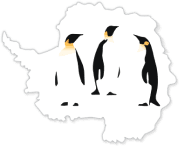This post was written by Beth Connors, a graduate student in the Bowman marine microbial ecology lab at Scripps Institution of Oceanography at UC San Diego. Beth studies ecosystem dynamics and function of bacteria along the Western Antarctic Peninsula.
In 1914, as national hero and explorer Ernest Shackleton was preparing to embark on his Endurance expedition, a call was sent out for volunteers. Over five thousand people applied to sail to Antarctica, including three women: “Dear Sir Ernest” their letter began, “We ‘three sporty girls’ have decided to write and beg of you to take us with you on your expedition to the South Pole…. we do not see why men should have all the glory, and women none, especially when there are women just as brave and capable as there are men.” Their application was denied.
Antarctica was described as a “womanless continent of cold and snow” in a 1948 article from the Lincoln Journal Star, the same year explorer Jackie Ronne was exploring the Ronne (yes, named after her) Ice Shelf with her husband. Her notes from the expedition formed the basis for her husband’s book Antarctic Conquest. Full access to the continent for women was possible only in 1969, when the US Navy and National Science Foundation lifted their bans (yes, bans) on women working on the continent.

Important discoveries, including the ozone depletion mechanism in Antarctica, occurred in the decades following by female scientists (though you have probably heard of the ozone hole, you probably have not heard of who helped discover it, Dr. Susan Solomon). Women coming to the continent in the second half of the 20th century contributed to an ongoing cultural shift: that women can do the work as well as men. In 2019, just over a century after Shackleton’s rejection and the 50th anniversary of women on the ice, I was accepted as a graduate student in Dr. Jeff Bowman’s marine microbial ecology lab. For my PhD, I have visited the continent three times and spent in total over a year in Antarctica. I am collecting data for the National Science Foundation funded project Understanding Microbial Heterotrophic Processes in Coastal Antarctic Waters. Our project is working in conjunction with the Long Term Ecological Research (LTER) team that has studied everything from molecules to whales along the western Antarctic Peninsula (wAP) for the last 30 years. I write this from the small science library at Palmer Station, one of the three U.S. bases on the continent.
Doing field work, especially in a place as isolated as Antarctica, is not easy. I spend six months of the year far from my family and friends. Last year when I got home and I could eat fresh produce for the first time in four months, I cried eating a kale salad. I don’t even like kale, but the crunch of a fresh leaf after so long without was a profound experience. Antarctic field seasons can be especially isolating for female researchers and support staff. A recent report from the National Science Foundation found that 59% of women said they’d experienced harassment or assault while in Antarctica.

Systemic barriers still prevent female and other underrepresented researchers from performing important science. These barriers even include our provided Extreme Cold Weather gear (called ECW on the ice) which is only issued in male sizes. Last year, I watched a fellow researcher slip on ice and break her wrist in ill-fitting male boots. But don’t worry, officials told the Santa Cruz Sentinel in 1978 that the known problem of ill-fitting female field gear in Antarctica “is being quickly remedied…”
I bring up these hard truths not to besmirch the impressive legacy of scientific discovery on the continent or diminish how fortunate I feel to have spent time here. The opportunity to study climate change and microbial food webs in one of the fastest warming regions on the planet has impacted me deeply. Here, climate change is not a hypothetical phenomenon. I can hear our backyard glacier falling into the ocean every day, as it continues to retreat at a rate of roughly 8 meters a year. I can visit the small colonies of the local Adelie penguins, where the population has fallen by nearly 90% in the past thirty years. To understand and combat these huge environmental threats, we need better regulations and laws in place to protect all researchers and workers on the ice. Women on the continent are doing crucial polar research to better understand ice-shelf stability, climate variability and sea-level rise. We do not have time to waste on inequality, inequity, and ill-fitting boots.

In 2022, the Falklands Maritime Heritage Trust and Expedition Leader Dr. John Shears sailed on a South African icebreaker into the Weddell Sea to successfully locate the wreckage of Ernest Shackleton’s ship Endurance. The expedition used advanced Autonomous Underwater Vehicles (AUVs) to locate and film the ship at 3,000 meters on the sea floor over a century after it had been crushed by ice and sank in 1915. The cruise supported critical sea ice research, ship engineering studies, meteorological and oceanographic data collection in the poorly understood Weddell Sea. Most of the press releases of the expedition focused on the high definition video of the shipwreck hull, beautifully preserved and emblazoned with the ship’s name and a five pointed star. It was not nearly as remarkable that the expedition included female scientists, students, surveyors, photographers, and documentarians. I wonder if those sporty girls that were rejected by Shackleton over a century ago could have ever dreamed of this.
Happy 9th International Day of Women and Girls in Science!
 ASOC
ASOC